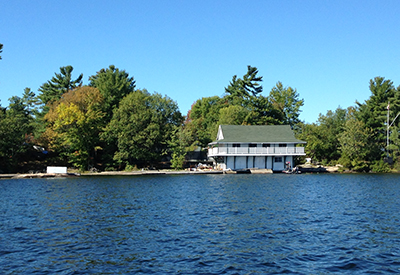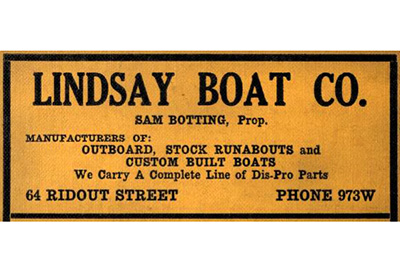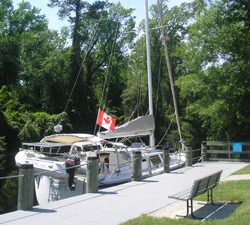The Spirit of Haida Gwaii

These “islands on the edge” are alive with the spirit of the Haida people, and a cruise here is an unforgettable experience.
There is a special place – north of Vancouver Island and west of the northern British Columbia coast – that is inhabited by the spirit of the Haida people. Haida Gwaii, formerly known as the Queen Charlotte Islands, is an archipelago of more than 150 islands, and one of the most unique destinations you can visit by boat in North America.
Haida Gwaii is remote and pristine, with a unique geological history. Glaciers covered this area and receded 2,000 years before they left the rest of BC, resulting in a rich ecosystem with some species of plants and animals not seen anywhere else in the world. It has been referred to as the “Galapagos of the Northwest,” with hundreds of species of birds, unique species of bears, and many trees and plants growing in areas from the wet rainforests of the western coast to the dryer forests on the eastern side of the islands.
 Haida Gwaii means “Islands of the People” in the language of the first people to settle here. The Haida were respected along the coast as ambassadors and warriors, with a unique culture. Over 10,000 inhabited this area at one time, until many succumbed to smallpox and other diseases from the western world in the late 1800s. By 1900, only 350 remained.
Haida Gwaii means “Islands of the People” in the language of the first people to settle here. The Haida were respected along the coast as ambassadors and warriors, with a unique culture. Over 10,000 inhabited this area at one time, until many succumbed to smallpox and other diseases from the western world in the late 1800s. By 1900, only 350 remained.
A visit to Haida Gwaii and the Gwaii Haanas National Park Reserve takes you to a special place where you can see what remains of this once great culture. As you walk the trails through the rainforest and the moss-covered canyons around the old villages, you may well feel the presence of the people who once lived here.
The Gwaii Haanas National Park Reserve and the Protected Area were created in 1987. The reserve is unique in Canada, jointly managed by the Haida and the government of Canada; it includes the land and the surrounding sea. A visit requires a reservation for the time you will be in the protected areas, and payment of a daily fee. All visitors are required to attend an informative 90-minute orientation 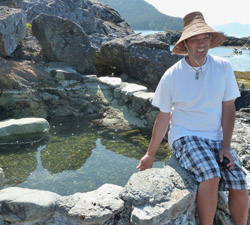 in Skidegate or prior to the cruising season in Vancouver, Sidney or Seattle. (See the sidebar “Planning Your Visit to Haida Gwaii” for details.)
in Skidegate or prior to the cruising season in Vancouver, Sidney or Seattle. (See the sidebar “Planning Your Visit to Haida Gwaii” for details.)
Crossing Hecate
We started our cruise to Haida Gwaii from Prince Rupert. The northern route from Ogden Channel and the Spicer Island group offers the shortest crossing of formidable Hecate Strait, about 65 miles. The strait is shallow, from 50 to 115 feet in depth, the result of layers of sediment from the ice age deposited over millions of years. Strong winds are common here year-round and can whip up short, confused seas that make for uncomfortable passages. It is important to choose weather windows carefully here. It is wise to start crossings as early as possible in the day when the winds should be lighter.
We were part of a flotilla of five Grand Banks yachts on charter from Bellingham, Washington-based NW Explorations. 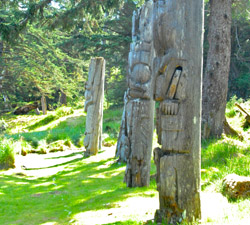 The flotilla was returning from a summer cruise in Southeast Alaska. (NW Explorations runs a unique program of guided flotillas where one can charter a yacht for two week or more legs.) The fleet ranged from 42’ to 52’, some with stabilization and some without. A crossing speed of 8.5 knots was set with our boat M/V Deception, a GB 49, in the lead, NW Explorations owner Brian Pemberton at the helm.
The flotilla was returning from a summer cruise in Southeast Alaska. (NW Explorations runs a unique program of guided flotillas where one can charter a yacht for two week or more legs.) The fleet ranged from 42’ to 52’, some with stabilization and some without. A crossing speed of 8.5 knots was set with our boat M/V Deception, a GB 49, in the lead, NW Explorations owner Brian Pemberton at the helm.
To minimize our crossing time to Queen Charlotte City on Graham Island, the fleet spent the night before departure in a beautiful anchorage in the Spicer Island group. The forecast for our eight-hour crossing appeared fine in the early morning, with the probability that winds would pick up near midday. The midpoint of our crossing, the North Hecate Strait weather buoy (46183), reported calm conditions for our departure. We planned to monitor the buoy reports throughout our crossing. As a precaution, all of the boats were secured and prepared for heavy seas. Though we had occasional periods of fog and soft rain, seas were unusually calm for the entire crossing.
We arrived at Maude Channel which separates Graham Island to the north and Moresby Island to the south. We passed Skidegate on the northern shoreline, site of the park reserve offices and the Haida Heritage Centre where our orientation briefing was held. Near the Queen Charlotte City floats there are shops, restaurants and a pub just a short walk away. You can also anchor in nearby Bearskin Bay.
We spent the next day exploring the area and provisioning. The briefing that afternoon was informative, and the exhibits and ceremonial poles on display were impressive as we began to learn more about Haida culture.
Scenic Passages
The next morning we timed our early departure to pass through Louise Narrows one hour before high tide. This small-boat passage is scenic, shallow and narrow, just 30 feet across in places. It is best to travel through it before high water – if you run aground, the rising tide will float you off.
We could see sea urchins on the bottom through the clear water of the narrows. In places, the depth sounder showed less than five feet under our keel, adding a bit of excitement to the passage. We filed through with a Securité call on VHF 16 and a sound of the horn. Opposing traffic would have to wait once we entered the narrows – there was definitely not room for two vessels to pass safely.
Once through the narrows, just under a mile in length, we continued through Selwyn Inlet and worked our way down to narrow Dana Passage. Here the water was deeper and the narrow section was about 100 yards wide.
Next, we entered Logan Inlet and crossed the boundary of the park reserve and the Haida Heritage Site. We continued under clear blue skies, watching for bears and other wildlife. We turned into Crescent Inlet, our overnight anchorage, just outside the reserve. An evening in Crescent Inlet does not require payment of the reserve’s daily fee.
The head of Crescent Inlet was a perfect anchorage, well protected with a snow-laced bowl above. There was a creek bed to explore and an area noted in the harbour diagram as a grassy meadow. “Grassy meadow” is code for bear country and we kept our eyes open. Sure enough, a black bear soon ambled out to munch on the grass.
Hot Springs
The next morning started once again under a sunny Pacific high. Soon we were back inside the reserve on our way to Hot Spring Island, the first of the Haida protected sites with a procedure for us to follow before coming ashore.
Hot Spring Island, with its baths, is one of the most popular sites in Gwaii Haanas. The water is part of an old aquifer fed by rainwater percolating down on much larger Lyell Island, about three miles to the north. Some of the water hits a thin spot in the earth’s surface, where it is superheated and bubbles up on Hot Spring Island. There it is directed into rock pools that overlook the water.
We had heard about the Haida native watchmen in the protected areas and we wondered what to expect. We called one hour ahead on their radio frequency, VHF 06, and they advised us to call when we arrived. Only 12 people are allowed on the island at one time and we divided our group accordingly. Once we anchored the boats, we checked in and were told that a group was still on the island and they would call us in next. In less than an hour we got the call. The first group was shuttled over and greeted warmly by the watchmen, David and Paul. As we walked up the white shell-lined path, David told us the history of the island. The Haida viewed this as a mystical place. They did not fully understand the steam and hot water bubbling up to the surface and thought it might be special land associated with the gods.
There were three natural rock pools at three different temperatures and a shower building. The water in all of the pools was fresh and high in mineral content, but without a sulfurous odour. Most of us chose the moderately warm Cliffside Pool, with its view of the anchored boats below. Under sunny skies, with the mountains of Moresby Island on the western horizon, the view was incredible.
After a delightful one-hour soak, we headed back to our boats feeling very relaxed. Soon we were under way to our evening anchorage in Marshall Inlet. There are many inlets with suitable anchorage along this shoreline. To maintain the remote experience, the reserve has a rule that you are not allowed to anchor in a cove or inlet with another boat or group in sight. We rarely encountered another boat in Gwaii Haanas.
Historic Island
The next day we proceeded to Rose Harbour at the south end of Moresby Island, and to Anthony Island, or SGang Gwaay, as it is known in the Haida language. SGang Gwaay lies a few miles offshore to the west, shrouded in mist and looking otherworldly as you approach from Houston Stewart Channel. It appears to float, almost alone, amid the crashing waves of the open Pacific beyond. Anthony Island is recognized as a UNESCO World Heritage Site. It is a place few of us will ever have the privilege of seeing, as it can only be visited by boat.
The Haida watchmen at SGang Gwaay advised us to anchor in the cove on the northwest corner of the island and bring the dinghies ashore on the beach in a small protected cove on the western side. Once ashore, we followed the trail into the thick rainforest, its entrance marked by an orange fishing float hanging in the trees. As we walked in silence, with rocky outcroppings around us, we felt the spirit of the people who once inhabited this island.
When you emerge into the site of the old village of Ninstints, or SGang Gwaay Llnagaay, the spirit takes your breath away. You are surrounded by a field of ancient carved cedar poles that recount the history of the former chiefs and their families. The ruins of the old red cedar houses are just beyond and you begin to sense what this once-vibrant village might have felt like 150 or more years ago.
James, the watchman, pointed out the first pole and told us the story of the chief and his clan through the carved figures on the pole. Ceremonial poles were displayed inside and outside a house to tell the story of the family. Until very recently there was no written Haida language; oral history carried the Haida story from person to person, or it was told on carved poles. The poles were carved with basic tools like mussel shells and the hip bone of a bear. Mortuary poles were cut from logs that were raised upside down and set in rock and sand, with an opening carved into the broad top of the log to receive a bentwood box holding the body of the deceased chief.
The 14 to 20 houses of Ninstints sheltered a community of up to 400 people. Some of the houses were constructed with three tiers leading down to a fire pit in the centre. The chief of the village, the clan, or the house, and his family would occupy space against the back wall, while those of lesser stature arrayed themselves on the tiers moving forward towards the doorway. They slept on beds made of pillowy moss from the forest and stayed warm under sea otter pelts. The waters around the island provided mussels, clams, crab and fish. Part of the catch would be dried or smoked for later. There was plenty to eat and it was shared among all.
We learned that the entrance to the lagoon, formed by the islet in front of the village, allowed water access for the canoes on the beach. Neighbouring clans would enter and signal their intentions. Raised paddles meant they came in peace. Some would enter paddling in reverse with their backs to the village, showing trust.
Canoes were shaped and hollowed out of the mightiest old-growth yellow cedar logs felled from neighbouring islands. The canoes were massive and could carry over two tons of people and cargo. Some were more than 65’ long, with a beam of 10 to 20’. The Haida were expert seafarers and skilled in long-distance navigation. There are stories of Haida war canoe flotillas traveling as far as Baja California.
It is only a matter of time before this special place will return to nature and exist no more. While the poles were reset years ago, the policy now is to let them fall as they naturally decay. In the Haida culture, this represents the fading memory of their ancestry. James showed us pictures of the remaining poles as they stood in 1908 and again in 1947; we could see notable deterioration. It was clear that what we were seeing was something our next generation would probably never be able to see.
We departed for our boats on the trail past the poles and the foundations of the old houses, walking silently through deep cuts in the rocks that towered over two-and-half stories above us. It was a reminder of how small we are and how short our time is in the larger context of human habitation on this earth.
Story & Photos by Mark Bunzel
Mark Bunzel is editor and publisher of the Waggoner Cruising Guide, and the publisher at Fine Edge Nautical Publications. He is also the co-author of Cruising the Virgin Islands, the bestselling guide to the US and British Virgin Islands.
Planning Your Visit to Haida Gwaii
Preparations for a visit to Haida Gwaii must start well in advance. Reservations are required for your vessel, and the entire crew needs to attend an orientation briefing before entering the Protected Areas of the Gwaii Haanas National Park Reserve and Haida Heritage Site. A daily fee needs to be paid for each member of your crew for the days they will be in the reserve. Details on fees and reservations can be found on the Parks Canada Gwaii Haanas National Park Reserve website: www.pc.gc.ca/pn-np/bc/gwaiihaanas/index.aspx.
Determine your itinerary and the days you plan to be in the protected areas of the park. Make your reservation with Parks Canada Gwaii Haanas office at 1-877-559-8818. Reservations are accepted after April 1. July to mid-August is the most popular time to visit the reserve and availability is limited, so make reservations early.
You can attend the orientation at the Haida Heritage Centre the day before you enter the reserve. For several years, Parks Canada has also offered orientation sessions in Vancouver, Sidney and Seattle in early May. Call the number above to inquire about the schedule. If you and your crew take the orientation program before your visit you may bypass Queen Charlotte City and head directly into the reserve.
Many cruisers depart from just south of Prince Rupert for the shortest crossing of Hecate Strait, 65 miles. You could also go directly to Haida Gwaii from the top of Vancouver Island for a possible overnight crossing of 120 miles, weather and boat speed permitting.
BC Ferry service from Prince Rupert to Queen Charlotte City is available for those with trailerable boats.
Cruising information is available in Exploring the North Coast of British Columbia by Don and Reanne Douglass, available from FineEdge.com.
A very good travel guide is Haida Gwaii – The Queen Charlotte Islands by Dennis Horwood. It is available at many bookstores and online.
If you wish to learn more about SGaang Gwaay, the book Ninstints – Haida World Heritage Site by George F. MacDonald includes many pictures and illustrations depicting the interesting history of the village, its houses and poles.



